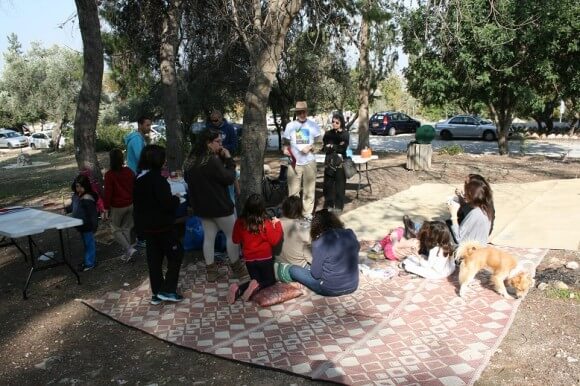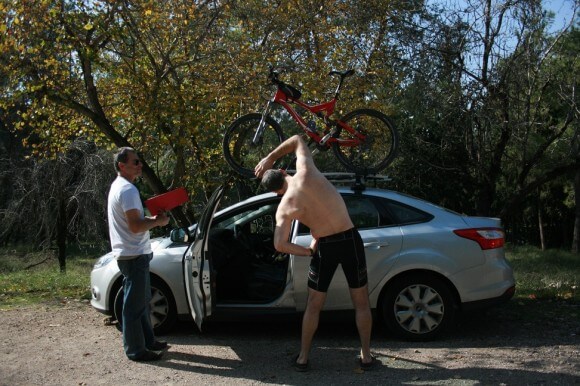
As part of Zochrot’s New KKL project we surveyed 200 visitors to Canada Park on Saturdays, from November, 2013 through January, 2014 (Editor’s Note: KKL is the acronym of the Hebrew name of the Jewish National Fund). The interviewers were Eitan Bronstein Aparicio and Jeremy Milgrom. The respondents were people they met in the park who agreed to participate in the survey.

First question: “Are we inside the Green Line or outside it – that is, on the West Bank?” The map to the left shows that the area where visitors were surveyed is located on the West Bank, beyond the Green Line.
150 of the 200 respondents – 75% – said “We’re inside the Green Line.” Not a few added, “certainly,” or “of course” inside the Green Line. They were very surprised to discover their mistake. A young couple who had been surprised by the information ran into Zochrot’s interviewer two hours later and said, “We’re still trying to digest the information you provided.”
14 didn’t know the answer; 36 knew we were beyond the Green Line. Some, particularly older respondents, knew a great deal about what happened in the area during the 1948 war, and about its capture in 1967. While we didn’t record information about the respondents’ background, Israelis from the former Soviet Union generally were less knowledgeable about the area’s history.

Second question: “Are you aware of any localities that were once located in the area of the park – two thousand years ago, one thousand years ago, or fifty years ago?” 88 knew about some localities, even if most weren’t able to name them. They knew, or had heard of, Roman localities, Jewish localities (Tel Ayalon) or Arab localities. 112 didn’t know of any localities that had once been located in the Canada Park area.
Third question: “Do you know about any Arab/Palestinian localities that were once located in the area of the park?”48 knew or had heard about Arab localities. Most didn’t know much about them, or their names, only that until the 1967 war they’d been located in the area where the park was established.
152 knew nothing about the Palestinian localities in the park’s area, and even when we pointed out their ruins they didn’t know what they were.

Fourth question: “What do you think about the KKL erecting signs in Canada Park and other parks it runs explaining the history of Palestinian villages that had been there?”137 agreed. Most of the respondents favored erecting signs, unlike KKL’s practice of avoiding providing information on its signs about the demolished villages within the park area.
Many respondents stressed the importance of knowing the history regardless of their political views about the conflict. Others said that it was important to explain about the Palestinian villages precisely in order to stress and justify what occurred in 1967. Those opposed to the 1967 conquest said that signs would remind people of the injustice of demolishing the villages, which is important.
Responses to the survey indicate that a large majority of visitors to Canada Park aren’t aware of the existence of the villages of ‘Imwas and Yalu that were located there until 1967, even though their ruins are abundant in the area. To generalize from this [lack of] knowledge, we can conclude that most visitors to KKL forests in Israel know almost nothing about Palestinian villages destroyed by Israel during the Nakba, which had been located within the area of those forests. Therefore, it’s encouraging that most Israelis agree with the idea that the KKL should erect signs explaining about those villages.
Translation to English: Charles Kamen. This post originally appeared on the Zochrot website.


Fascinating. Bravo! Maybe some billionaire could buy a full page in major North American newspapers from time to time, to diksplay a map of Israel showing its border. aka Green Line.
Is there a lack of good maps in Israel?
Thank you Eitan Bronstein Aparicio and Jeremy Milgrom.
Thank you Zochrot for your efforts to educate and more.
This quote from the above is a good illustration of how many nations deal with conquest and dispossession. Is it enough? It depends on many factors. Nobody will be entirely happy that is for certain:
“Many respondents stressed the importance of knowing the history regardless of their political views about the conflict. Others said that it was important to explain about the Palestinian villages precisely in order to stress and justify what occurred in 1967. Those opposed to the 1967 conquest said that signs would remind people of the injustice of demolishing the villages, which is important.”
KKL = Keren Kayemet LeYisrael = Jewish National Fund